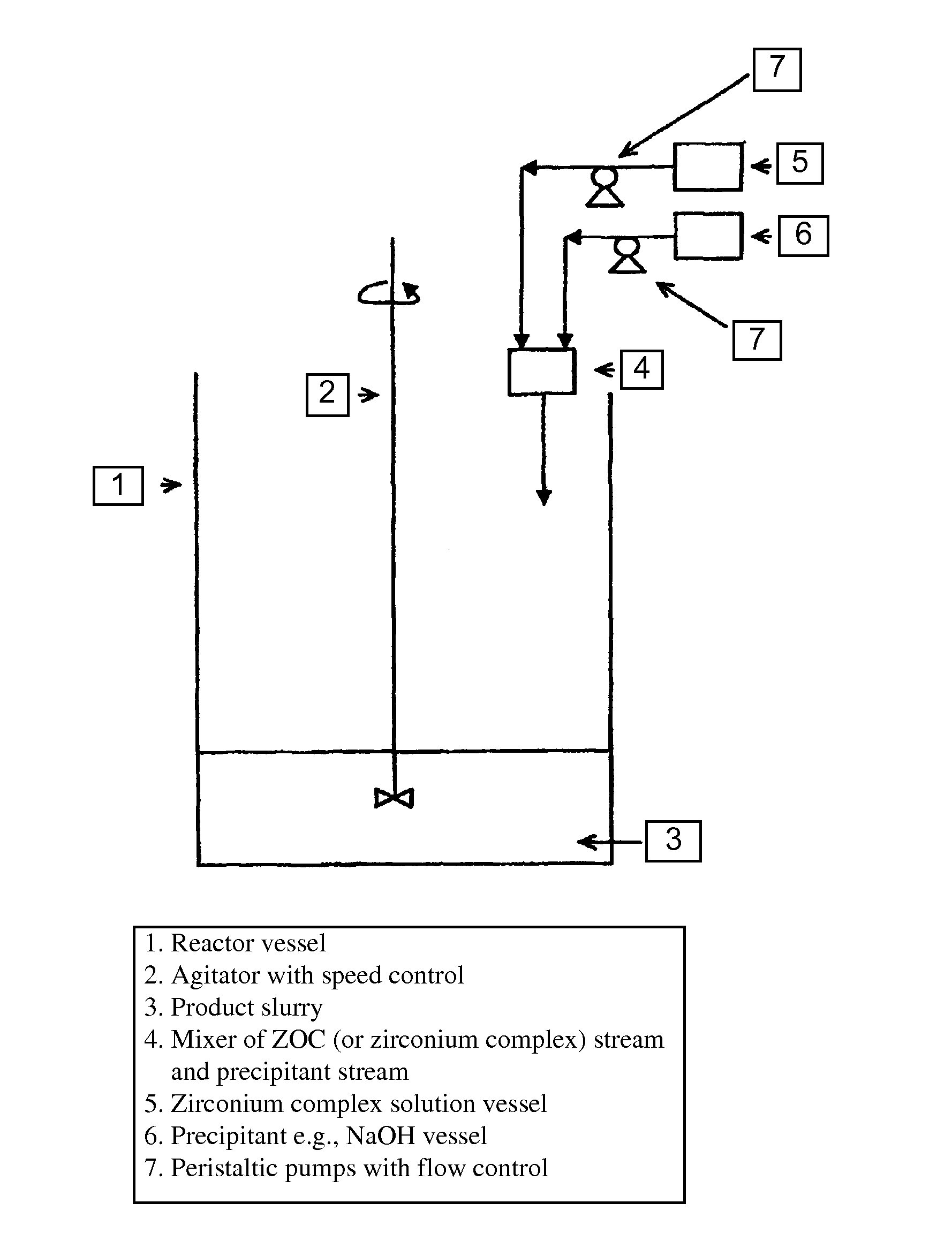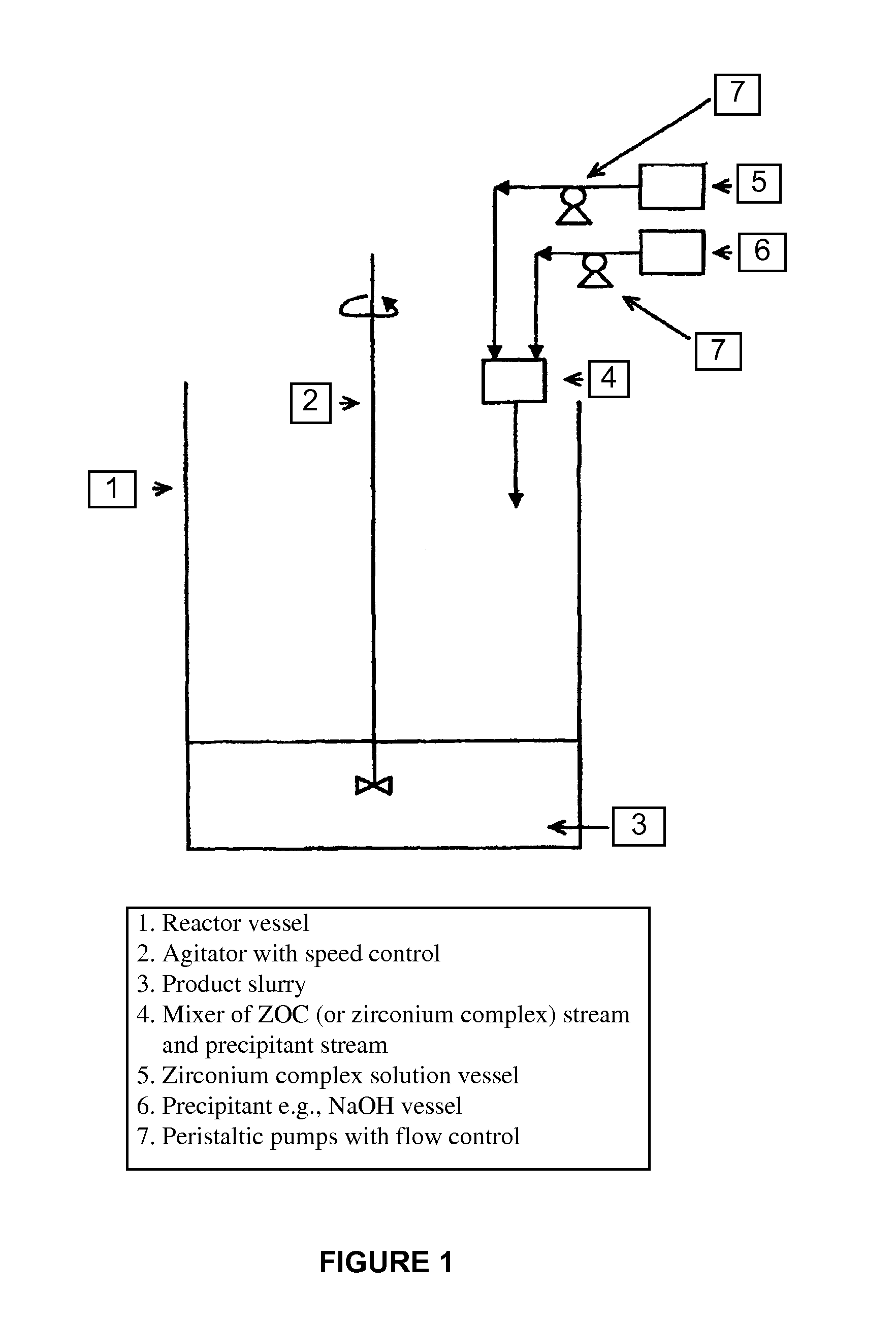Methods Of Synthesizing Hydrous Zirconium Oxide And Other Oxides
a technology other oxides, applied in the field of hydrous zirconium oxide particles and methods of making hydrous zirconium oxide particles, can solve the problems of poor bet surface adsorption area and capacity, low porosity, and non-uniform particle size of hydrous zirconium oxides
- Summary
- Abstract
- Description
- Claims
- Application Information
AI Technical Summary
Benefits of technology
Problems solved by technology
Method used
Image
Examples
example 1
Preparation of Sol Gel HZO by Using 1% Tartaric Acid as Additive to ZOC
[0083]The synthesis consisted of the following steps:
[0084]Step 1—500 g zirconium oxychloride octahydrate (ZOC) was dissolved in 300 ml DI or RO water by magnetic stirring in a 1 L reservoir (A) until the solution was clear;
[0085]Step 2—5 g tartaric acid (1 wt % of ZOC amount) was then dissolved in 100 ml DI or RO water in a small beaker to obtain a clear solution and afterwards added to the ZOC solution prepared in Step 1 slowly with magnetic stirring until the precipitate formed as re-dissolved completely to form a clear solution of partial zirconium tartarate complex.
[0086]Step 3—800 ml 50% NaOH (Technical Grade) solution was introduced in a 2 L reservoir (B) and another 200 ml 50% NaOH in a 3 L reactor vessel equipped with a motor / stainless steel agitator setup.
[0087]Step 4—With the agitator of the reactor on at slow speed (˜40 RPM), the zirconium tartarate complex solution from reservoir (A) and the NaOH sol...
example 2
[0092]Example 1 was repeated by using (i) acetic acid in the amount about 1 wt % of ZOC; (ii) soda ash in the amount about 1 wt % of ZOC; and (iii) sodium sulfate in the amount about 1 wt % of ZOC as additives to ZOC and the sulfate adsorption capacity of each product was compared to that using tartaric acid as the additive in Example 1. It was found that additives with lower molecular weight than tartaric acid also had a smaller sulfate adsorption capacity due to the smaller BET surface area and pore size / pore volume as shown below:
Sulfate AdsorptionAdditivesM wtCapacityAcetic acid 6011.04 mg / g HZOSoda ash~106 7.57 mg / g HZOSodium sulfate14214.89 mg / g HZOTartaric acid 150.08715.96 mg / g HZO
example 3
[0093]Example 1 was repeated by using (i) EDTA in the amount about 1 wt % of ZOC; (ii) PVA in the amount about 0.5 wt % ZOC and (iii) sulfonic acid in the amount about 0.5 wt % ZOC and lauryl sulfate (sodium dodecyl sulfate) in the amount about 1 wt % of ZOC as additives to ZOC and the sulfate adsorption capacity of each was compared to that using tartaric acid as the additive in Example 1. It was found that additives with higher molecular wt. than tartaric acid also had higher sulfate adsorption capacity due to the larger BET surface area and pore size / pore volume as shown below:
AdditivesM wtSulfate Adsorption CapacityEDTA292.2419.83 mg / g HZOPVA124,000-186,00022.04 mg / g HZOSulfonic acid15217.71 mg / g HZOLauryl sulfate288.38 20.8 mg / g HZOTartaric acid150.08715.96 mg / g HZO
PUM
| Property | Measurement | Unit |
|---|---|---|
| molecular weight | aaaaa | aaaaa |
| particle size | aaaaa | aaaaa |
| particle size distribution | aaaaa | aaaaa |
Abstract
Description
Claims
Application Information
 Login to View More
Login to View More - R&D
- Intellectual Property
- Life Sciences
- Materials
- Tech Scout
- Unparalleled Data Quality
- Higher Quality Content
- 60% Fewer Hallucinations
Browse by: Latest US Patents, China's latest patents, Technical Efficacy Thesaurus, Application Domain, Technology Topic, Popular Technical Reports.
© 2025 PatSnap. All rights reserved.Legal|Privacy policy|Modern Slavery Act Transparency Statement|Sitemap|About US| Contact US: help@patsnap.com



